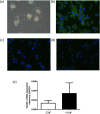Targeting Rapamycin to Podocytes Using a Vascular Cell Adhesion Molecule-1 (VCAM-1)-Harnessed SAINT-Based Lipid Carrier System
- PMID: 26407295
- PMCID: PMC4583306
- DOI: 10.1371/journal.pone.0138870
Targeting Rapamycin to Podocytes Using a Vascular Cell Adhesion Molecule-1 (VCAM-1)-Harnessed SAINT-Based Lipid Carrier System
Abstract
Together with mesangial cells, glomerular endothelial cells and the basement membrane, podocytes constitute the glomerular filtration barrier (GFB) of the kidney. Podocytes play a pivotal role in the progression of various kidney-related diseases such as glomerular sclerosis and glomerulonephritis that finally lead to chronic end-stage renal disease. During podocytopathies, the slit-diaphragm connecting the adjacent podocytes are detached leading to severe loss of proteins in the urine. The pathophysiology of podocytopathies makes podocytes a potential and challenging target for nanomedicine development, though there is a lack of known molecular targets for cell selective drug delivery. To identify VCAM-1 as a cell-surface receptor that is suitable for binding and internalization of nanomedicine carrier systems by podocytes, we investigated its expression in the immortalized podocyte cell lines AB8/13 and MPC-5, and in primary podocytes. Gene and protein expression analyses revealed that VCAM-1 expression is increased by podocytes upon TNFα-activation for up to 24 h. This was paralleled by anti-VCAM-1 antibody binding to the TNFα-activated cells, which can be employed as a ligand to facilitate the uptake of nanocarriers under inflammatory conditions. Hence, we next explored the possibilities of using VCAM-1 as a cell-surface receptor to deliver the potent immunosuppressant rapamycin to TNFα-activated podocytes using the lipid-based nanocarrier system Saint-O-Somes. Anti-VCAM-1-rapamycin-SAINT-O-Somes more effectively inhibited the cell migration of AB8/13 cells than free rapamycin and non-targeted rapamycin-SAINT-O-Somes indicating the potential of VCAM-1 targeted drug delivery to podocytes.
Conflict of interest statement
Figures





References
Publication types
MeSH terms
Substances
LinkOut - more resources
Full Text Sources
Other Literature Sources
Miscellaneous

